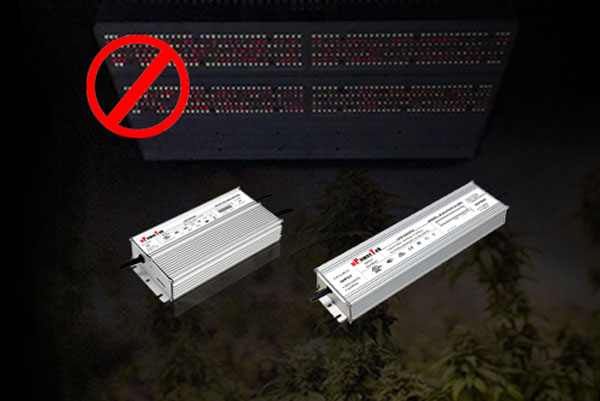I.Introduction
Definition of Isolation
In the field of LED power supplies, “isolation” refers to the presence of electrical separation between the input and output circuits. This separation is typically achieved using a transformer, which prevents direct electrical contact between the two sides. Isolated power supplies enhance safety by reducing the risk of electric shock and protecting sensitive components from high-voltage surges.
What is a Non-Isolated LED Driver?
A non-isolated LED driver, as the name suggests, lacks this electrical separation. Instead of using a transformer to provide isolation, these drivers employ a direct electrical connection between the input and output. They typically rely on buck, boost, or buck-boost converter topologies to regulate voltage and current for the LEDs. Due to the absence of a transformer, non-isolated drivers offer higher efficiency, reduced size, and lower cost, making them attractive for various applications. However, they also introduce safety concerns, as their output is not electrically separated from the mains voltage.
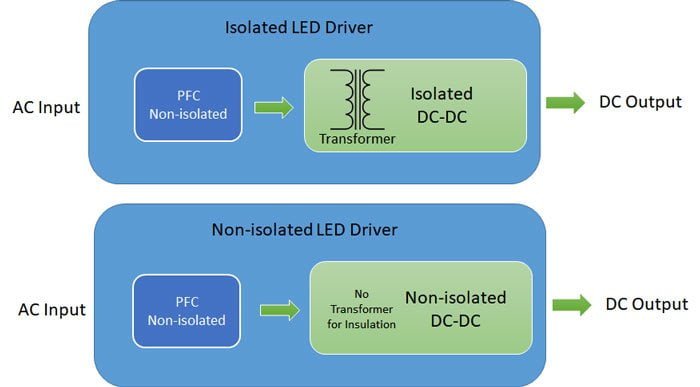
Applications
Non-isolated LED drivers are widely used in various lighting and electronic applications, including:
- LED Lighting – Used in indoor, outdoor, and horticultural lighting, where efficiency and cost savings are key factors.
- Consumer Electronics – Found in display backlighting, signage, and other compact electronic devices.
- Industrial Applications – Used in high-efficiency lighting systems and power-constrained environments.
As non-isolated LED drivers continue to evolve, their advantages in terms of efficiency and cost make them a compelling choice for many applications. However, safety and performance considerations remain critical factors in determining their suitability for specific use cases.

II. Isolated vs. Non-Isolated LED Drivers
When selecting an LED driver, one of the most important considerations is whether to use an isolated or a non-isolated design. Each type has distinct advantages and trade-offs, making them suitable for different applications.
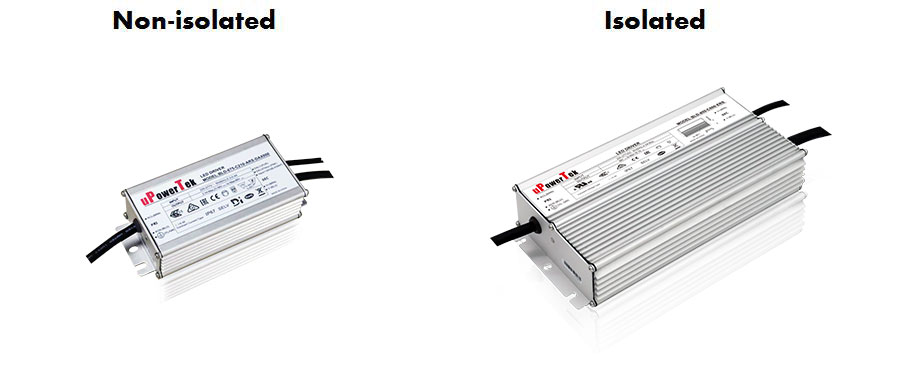
Performance Comparison
| Non-isolated | Isolated | |
|---|---|---|
| Topology | Buck,boost,buck-boost etc. | Flyback,forwardhalf bridge LLC etc. |
| Complexity | Low | Mid and high |
| Efficiency | High | Mid |
| Output Voltage | High | Mid and low |
| Output Safety | Unsafe | Relatively safe, safe SELV or class 2 can be achieved |
| Cost | 25%lower | 25% higher |
| Application | Built-in | Independent |
| Luminaire Design | More insulation needed | Easy |
Use Cases
When to Choose Isolated Drivers
- Safety-Critical Applications – In environments where users may have direct access to LED fixtures (e.g., commercial or residential lighting), isolation provides an extra layer of protection.
- Outdoor and Wet Environments – Locations exposed to moisture or potential contact require isolation to minimize shock hazards.
- Medical and Industrial Applications – Equipment requiring strict safety standards typically employs isolated power supplies.
When to Choose Non-Isolated Drivers
- Cost-Sensitive Projects – If minimizing costs is a priority, non-isolated drivers provide a more affordable solution.
- High-Efficiency Applications – When maximizing energy efficiency is critical, non-isolated designs help reduce power losses.
- Compact Designs – Space-constrained applications, such as small LED modules and integrated fixtures, benefit from the reduced size of non-isolated drivers.
While non-isolated LED drivers offer distinct advantages in terms of efficiency, cost, and size, their safety limitations make them unsuitable for all applications. Understanding these trade-offs helps in selecting the right driver type based on the specific needs of the lighting system.
III. Application Considerations
When designing or selecting an LED driver, various factors must be considered to ensure safety, reliability, and performance. Non-isolated drivers, while efficient and cost-effective, introduce specific challenges that must be addressed in practical applications.
1. Safety Considerations
Safety Standards and Certifications
Non-isolated LED drivers must comply with industry safety standards to ensure reliable operation and user protection. Some key certifications include:
- UL (Underwriters Laboratories) – Ensures electrical safety and fire resistance, commonly required in North America.
- IEC (International Electrotechnical Commission) – Defines global safety requirements for electronic devices, including LED drivers.
- ENEC (European Norms Electrical Certification) – Ensures compliance with European safety regulations.
Creepage and Clearance Requirements
Since non-isolated drivers have no transformer to separate high- and low-voltage sections, proper creepage (surface distance) and clearance (air gap) must be maintained to prevent accidental electrical discharge. These distances vary depending on the input voltage and environmental conditions, such as humidity and pollution levels.
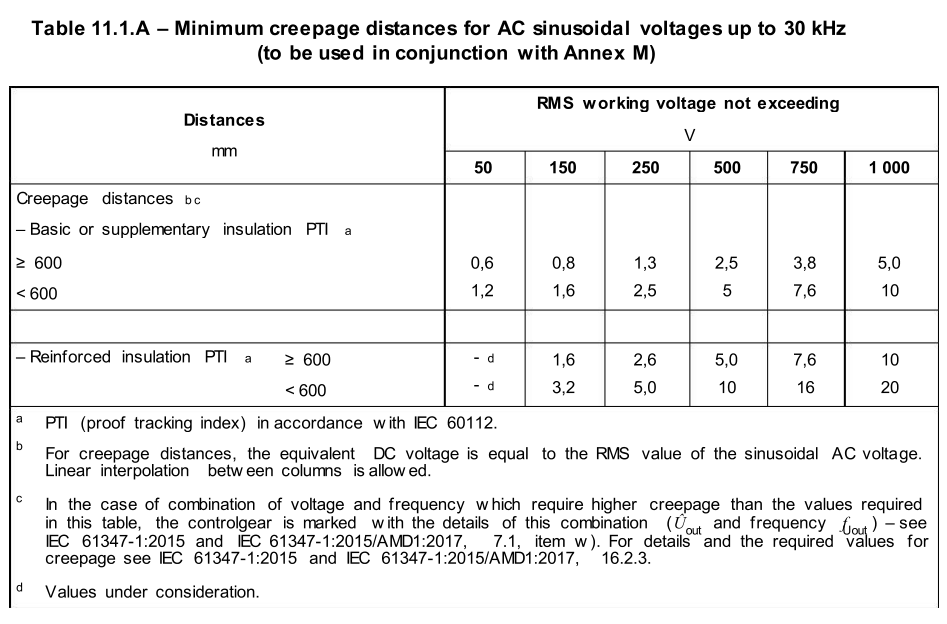
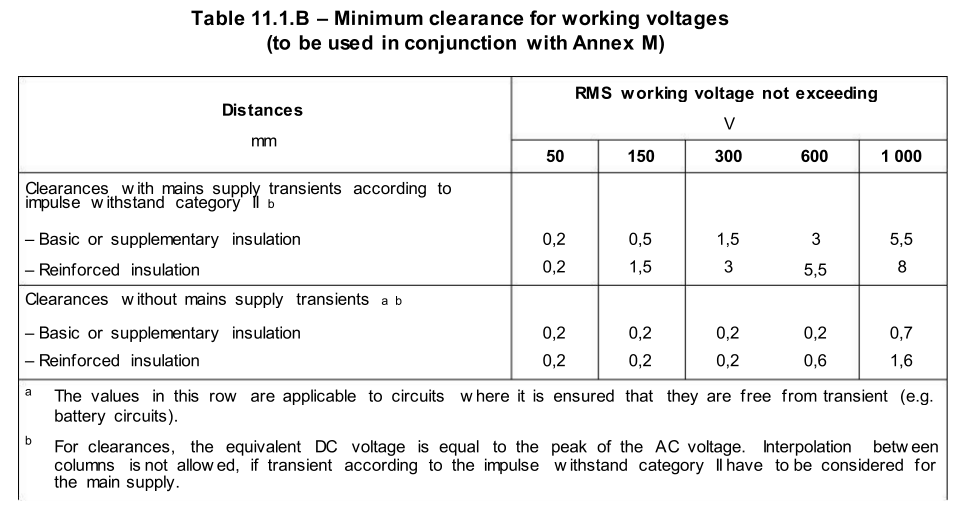
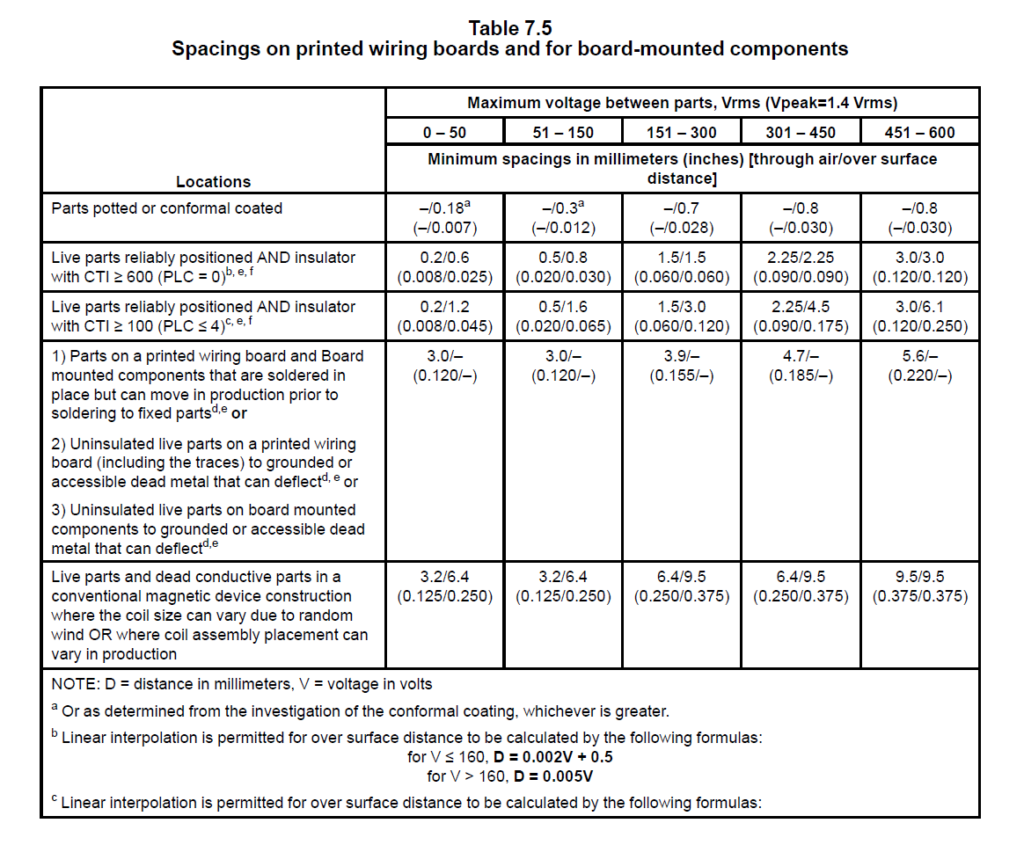
Proper Grounding and Insulation
To mitigate shock hazards, non-isolated drivers must be properly grounded, and their enclosures should be designed with adequate insulation. Double-layer PCB designs and protective coatings can help improve safety and durability.
2. Afterglow
Causes of Afterglow in Non-Isolated Drivers
Afterglow refers to a situation where LEDs continue to emit dim light even after the power is turned off. This issue is more common in non-isolated drivers due to residual voltage or leakage current in the circuit. Key causes include:
- Capacitive coupling between live and neutral wires.
- Leakage current from the driver’s input stage.
- Insufficient discharge of stored energy in capacitors.
There is an article here to explain how the afterglow is generated in detail.
Impact on LED Performance and User Experience
Persistent afterglow can be undesirable in lighting applications where complete darkness is required, such as bedrooms, theatrical or horticulture lighting settings. It may also lead to user complaints and affect product perception.
Solutions to Prevent Afterglow
- Using a Relay – A relay can fully disconnect the power supply from the circuit when switched off, eliminating leakage paths. There is built-in relay in uPowerTek non-isolated LED drivers, so it’s glow free from uPowerTek non-isolated LED drivers.
- Lower Residual Voltage Designs – Some non-isolated drivers incorporate discharge resistors to quickly drain excess voltage when turned off.
- Adding a Bleeder Resistor – A small resistor across the LED terminals can help dissipate residual energy and prevent afterglow.
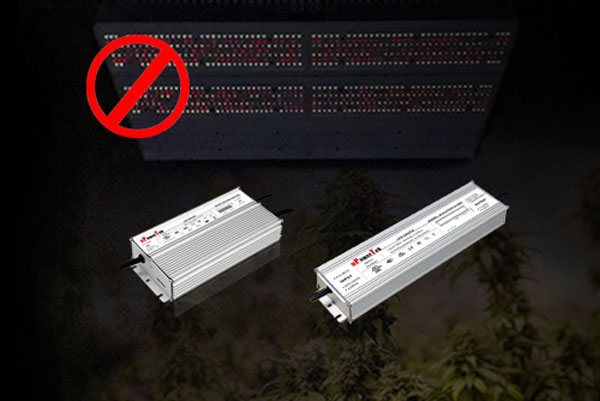
3. Let-Through Voltage (Residual Voltage)
Definition and Impact on LED Boards
Let-through voltage refers to the residual voltage that passes downstream when a surge protective device (SPD) activates in response to electrical disturbances such as surges, sags, swells, and fast transients. These disturbances, collectively known as “dirty power,” are common in electrical distribution systems and can negatively impact electronic components.
In LED driver circuits, let-through voltage is particularly important because it determines the level of electrical stress that reaches the LED board. While LED drivers include built-in surge protection mechanisms, the actual let-through voltage—especially in non-isolated designs—can be significant and may exceed the tolerance of LED PCBs, leading to potential degradation or failure.

Comparison Between Isolated and Non-Isolated Drivers
- Isolated LED Drivers – Due to transformer-based isolation, these drivers naturally limit let-through voltage, typically keeping it below 2kV, which aligns with the withstand rating of most LED PCBs.
- Non-Isolated LED Drivers – Without a transformer to act as a buffer, non-isolated drivers tend to allow significantly higher let-through voltage to reach the LEDs, increasing the risk of electrical overstress (EOS) and premature failure.
Mitigation Techniques
To reduce the impact of let-through voltage in non-isolated LED drivers, several design and protection strategies can be implemented:
- Surge Protection Devices (SPDs) – Using properly rated SPDs helps absorb excess energy and limit the voltage passing to sensitive components.
- Transient Voltage Suppressors (TVS Diodes) – TVS diodes can clamp transient spikes and protect both the LED driver and LED modules.
- Optimized Driver Design – Advanced circuit topologies and filtering components can help lower the let-through voltage in non-isolated drivers.
- Enhanced PCB Design for LED Boards – Increasing the withstand capability of LED PCBs (e.g., designing for higher voltage tolerance) can help mitigate the effects of let-through voltage.
By addressing these considerations, non-isolated LED drivers can be safely and effectively integrated into lighting applications while mitigating potential risks. Proper design and component selection play a crucial role in ensuring long-term reliability and compliance with safety standards.
IV. Conclusion
1. Summary of Key Points
Non-isolated LED drivers offer several advantages, including higher efficiency, smaller size, and lower cost, making them ideal for many applications. However, they also introduce challenges such as higher let-through voltage, potential safety risks, and afterglow issues. To ensure reliable operation, designers must consider proper insulation, grounding, surge protection, and compliance with safety standards when implementing non-isolated drivers.
A comparison with isolated drivers highlights key trade-offs:
- Efficiency & Cost: Non-isolated drivers are more efficient and cost-effective.
- Safety: Isolated drivers provide better protection against electric shock.
- Size & Weight: Non-isolated drivers are more compact, making them suitable for space-constrained applications.
Choosing between isolated and non-isolated LED drivers depends on the specific requirements of the application, balancing performance, cost, and safety considerations.
2. Future Trends
As the demand for high-efficiency and cost-effective LED solutions grows, non-isolated LED drivers are expected to see wider adoption across various applications, including:
- Smart lighting and IoT-connected systems – Improved driver designs will enhance energy efficiency and integration with intelligent control systems.
- Advanced safety technologies – Future developments may introduce better insulation techniques, integrated surge protection, and innovative circuit designs to mitigate safety risks.
- Higher reliability and performance – Emerging materials and circuit innovations will help reduce let-through voltage and improve the longevity of LED systems.
With ongoing advancements in LED driver technology, non-isolated drivers will continue to play a critical role in efficient, cost-effective lighting solutions, provided that proper safety measures and design considerations are in place.

V. FAQs (Frequently Asked Questions)
1. What is the main difference between isolated and non-isolated LED drivers?
The key difference is electrical isolation between the input and output:
- Isolated LED drivers use a transformer to separate the high-voltage input from the low-voltage output, improving safety and reducing electrical shock risks.
- Non-isolated LED drivers do not have this separation, resulting in higher efficiency, smaller size, and lower cost, but requiring additional precautions for safety.
2. Are non-isolated LED drivers safe to use?
Yes, but only when designed and installed correctly. Since the output is not electrically isolated from the input, non-isolated drivers require proper insulation, grounding, and compliance with safety standards to minimize risks of electric shock and fire hazards.
3. What are the key considerations when designing a luminaire with a non-isolated driver?
When integrating a non-isolated LED driver into a lighting fixture, consider:
- Safety Measures – Ensure proper insulation, grounding, and compliance with standards like UL and IEC.
- Thermal Management – Optimize heat dissipation to enhance reliability.
- Afterglow Prevention – Use appropriate circuit designs to prevent LEDs from glowing faintly when turned off.
- Surge Protection – Implement proper filtering and suppression techniques to handle electrical transients and reduce let-through voltage.
4. How can afterglow be prevented in non-isolated drivers?
Afterglow occurs due to leakage currents or residual voltage. Solutions include:
- Adding a relay to fully disconnect power when switched off.
- Using bleeder resistors to discharge residual voltage.
- Improving driver circuit design to minimize unintended current flow.
5. What are the benefits of using non-isolated LED drivers?
- Higher efficiency due to fewer energy losses.
- Smaller size and lower weight, making them ideal for compact applications.
- Lower cost, reducing overall system expenses.
- Simpler circuit design, which can lead to improved reliability in some cases.
6. What are the risks associated with non-isolated LED drivers, and how can they be mitigated?
The main risks include:
- Electric shock hazard – Requires proper insulation and user protection.
- Higher let-through voltage – Can stress LED boards, mitigated with SPDs, TVS diodes, and optimized PCB designs.
- Afterglow issues – Addressed with proper circuit components like relays and discharge resistors.
- Regulatory compliance challenges – Requires careful design to meet safety certifications.
By understanding these factors and implementing appropriate solutions, non-isolated LED drivers can be used effectively in a wide range of applications while maintaining safety and reliability.

